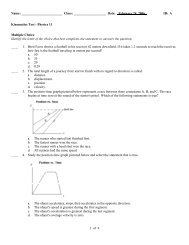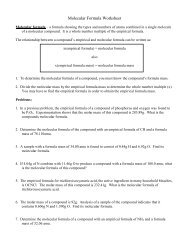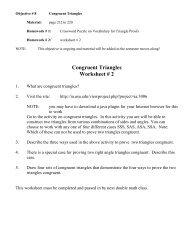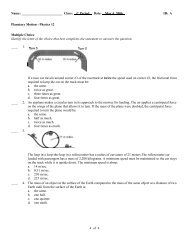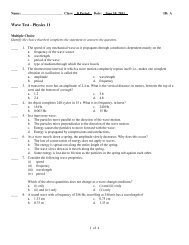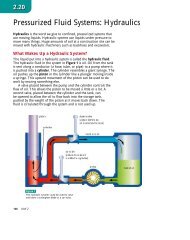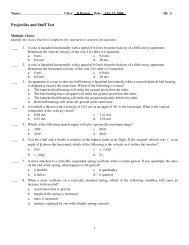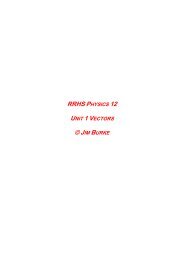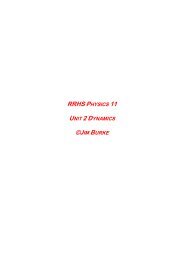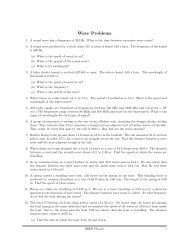Anaphylaxis - Cape Breton-Victoria Regional School Board
Anaphylaxis - Cape Breton-Victoria Regional School Board
Anaphylaxis - Cape Breton-Victoria Regional School Board
Create successful ePaper yourself
Turn your PDF publications into a flip-book with our unique Google optimized e-Paper software.
ANAPHYLAXIS (LIFE-THREATENING ALLERGIES)PROGRAMS & STUDENT SERVICES: 200<strong>Anaphylaxis</strong>: PSS 216Adoption Date: October 25, 1999Revised: January 2005; September 2012ScopeThis policy applies to all volunteers, students and staff who are required to provide care and services toany student who experiences a life-threatening response to anaphylaxis. This policy covers all locationswhere care and instruction are provided.PurposeTo create an allergy-safe or allergy-aware environment to ensure the safety of all students in the schoolcommunity who are at risk of life-threatening allergies by providing procedures for the management ofanaphylaxis.DefinitionsAllergen: any substance that can cause an allergic reaction, i.e. pollens, moulds, animal dander, housedust mites, foods, insect stings, medications, natural latex, etc.<strong>Anaphylaxis</strong>: a severe systemic allergic reaction which can be fatal, resulting in circulatory collapse orshock.Epinephrine: the drug form of a hormone (adrenaline) that the body produces naturally and is thetreatment or drug of choice to treat anaphylaxis. This treatment is life-saving.Auto-injector: a “user-friendly” pre-loaded syringe used to administer epinephrine.SymptomsAn anaphylactic reaction can involve any of the following symptoms, which may appear alone or in anycombination.‣ Skin system: hives, swelling, itching, warmth, redness, rash‣ Respiratory system (breathing): coughing, wheezing, shortness of breath, chest, pain/tightness,throat tightness, hoarse voice, nasal congestion or hay fever-like symptoms (runny, itchy nose andwatery eyes, sneezing), trouble swallowing‣ Gastrointestinal system (stomach): nausea, pain/cramps, vomiting, diarrhea‣ Cardiovascular system (heart): pale/blue colour, weak pulse, passing out, dizzy/lightheaded,shock‣ Other: anxiety, feeling of “impending doom”, headache, uterine cramps, metallic taste
Policy - <strong>Anaphylaxis</strong> (Life Threatening Allergies) Policy Number: PSS 216Policy StatementIn order to maximize the safety of each student within the school system who may be subject to severeallergic reactions (anaphylaxis), plans shall be put in place to: communicate information and awarenesson anaphylaxis, avoid exposures to life-threatening substances and to provide prompt, appropriateresponses if exposures do occur. Every effort will be made to control the school/learning environment inorder to minimize the exposure of identified causative allergens/agents as part of a prevention plan,whenever possible. This prevention should be a collaborative process involving parents, guardians, schoolstaff, students and the entire school community. Despite efforts to reduce the risk of exposure to zero, the<strong>Board</strong> cannot ensure an allergen/agent- free school/learning environment.Cross ReferenceProgramming for Students with Special NeedsAuthorizationThe policy has been authorized by the <strong>Board</strong> under motions number 2012-09-27.ResponsibilityIt is the responsibility of the Director of Programs and Student Services to ensure that this policy andadministrative procedures are implemented.ImplementationThis policy will be implemented by each school Principal in consultation with the Coordinator of <strong>School</strong>Services.ProceduresAll schools will be provided with two copies of <strong>Anaphylaxis</strong> in <strong>School</strong>s & Other Settings 2 nd Edition(2011). <strong>School</strong>s are to use this reference document for emergency protocols and appendices indeveloping their own school anaphylaxis plan.1. A school anaphylaxis plan must be in place and can be modeled after the suggested plan in<strong>Anaphylaxis</strong> in <strong>School</strong>s & Other Settings 2 nd Edition (2011).The plan must includeinformation about avoidance strategies, communication strategies, staff training, andemergency protocol.2. Two copies of <strong>Anaphylaxis</strong> in <strong>School</strong>s & Other Settings 2 nd Edition (2011) will be providedto each school. One copy is to remain in the administrative office of the school and the otherin a staff room.<strong>Cape</strong> <strong>Breton</strong>-<strong>Victoria</strong> <strong>Regional</strong> <strong>School</strong> <strong>Board</strong>Policy and Administrative Procedures
Policy - <strong>Anaphylaxis</strong> (Life Threatening Allergies) Policy Number: PSS 2163. A school anaphylaxis plan must be reviewed at the start of each school year and at the start ofeach semester for semestered schools.4. An <strong>Anaphylaxis</strong> care plan must be in place for each student at risk of anaphylaxis. (Refer toAppendix B and C – <strong>Anaphylaxis</strong> in <strong>School</strong>s and Other Settings.)5. An <strong>Anaphylaxis</strong> emergency plan must be in place for each student at risk of anaphylaxis(Refer to Appendix D – <strong>Anaphylaxis</strong> in <strong>School</strong>s and Other Settings.) A copy of the AllergyAlert Form must be posted in the staffroom, placed in the child’s cumulative record card andshared with the Coordinator of Transportation as well as the bus drivers.6. Principals are responsible for arranging for regular training (annually at a minimum) for allemployees and others who are in contact with students at risk of anaphylaxis.7. The anaphylaxis emergency care plan must be written out as part of the program planning forthe student.8. <strong>School</strong> Personnel should adhere to the six key recommendations in the emergencymanagement of anaphylaxis, including:8.1 Epinephrine is the first line medication which should be used for the emergencymanagement of a person having a potentially life-threatening allergic reaction.8.2 Antihistamines and asthma medications must not be used as first line treatment for ananaphylactic reaction.8.3 All individuals receiving emergency epinephrine must be transported to hospitalimmediately (ideally by ambulance) for evaluation and observation.8.4 Additional epinephrine must be available during transport to hospital. A second dose ofepinephrine may be administered within 5 to 15 minutes after the first dose is given IFsymptoms have not improved.8.5 Individuals with anaphylaxis who are feeling faint or dizzy because of impending shockshould lie down unless they are vomiting or experiencing severe respiratory distress.8.6 No person should be expected to be fully responsible for self-administration of anepinephrine auto-injector.9. <strong>School</strong> Personnel must be aware and respond as quickly and appropriately as possible in theevent of an anaphylactic reaction.9.1 Give epinephrine auto-injector (e.g. EpiPen or Twinject) at the first sign of a known orsuspected anaphylactic reaction.9.2 Call 9-1-1 or local emergency medical services. Tell them someone is having a lifethreateningallergic reaction.9.3 Give a second dose of epinephrine in 5 to 15 minutes IF the reaction continues orworsens.9.4 Go the nearest hospital immediately (ideally by ambulance), even if symptoms aremild or have stopped. The reaction could worsen or come back, even after propertreatment. Stay in the hospital for an appropriate period of observation as decided by theemergency department physician (generally about 4 hours).9.5 Call emergency contact person (e.g. parent, guardian).<strong>Cape</strong> <strong>Breton</strong>-<strong>Victoria</strong> <strong>Regional</strong> <strong>School</strong> <strong>Board</strong>Policy and Administrative Procedures
Policy - <strong>Anaphylaxis</strong> (Life Threatening Allergies) Policy Number: PSS 216Related GuidelinesCanadian <strong>School</strong> <strong>Board</strong>s Association document, ANAPHYLAXIS: A Handbook for <strong>School</strong> <strong>Board</strong>s<strong>Anaphylaxis</strong> in <strong>School</strong>s & Other Settings 2 nd EditionCBVRSB Guidelines for Administration of Medication to Studentswww.studentservices.ednet.ns.ca: Additional Link: <strong>Anaphylaxis</strong>: Education for a Life ThreateningAllergic ReactionAssociated FormsPolicy Review1. Review of this policy shall be the responsibility of the Director of Programs and Student Serviceswithin three years of the authorization date.2. The Co-ordinator of <strong>School</strong> Services shall ensure that the committee which does this review shallinclude the Director of Operational Services, the Co-ordinator of Transportation, a schoolprincipal, a parent of an anaphylactic school student, and such other individuals as the Coordinatorbelieves will ensure opportunity for input to be thorough and timely.DistributionAll PrincipalsMaintenance SupervisorDirector of Operational ServicesCo-ordinator of Transportation<strong>Board</strong> MembersAll Policy Manual HoldersCBVRSB Website<strong>Cape</strong> <strong>Breton</strong>-<strong>Victoria</strong> <strong>Regional</strong> <strong>School</strong> <strong>Board</strong>Policy and Administrative Procedures
CAPE BRETON-VICTORIA REGIONAL SCHOOL BOARDEMERGENCY ALLERGY ALERT FORM AND RESPONSE PLAN_________________________________NAME____________________CLASSALLERGY - DESCRIPTIONThis child has a DANGEROUS, Life-Threatening Allergy to thefollowing:_______________________________________________________________________________________________________________________________________________________________ POSSIBLE SYMPTOMS‣ Flushed face; hives; swelling; itchy lips, tongue, eyes‣ Tightness in throat, mouth, chest‣ Difficulty breathing or swallowing, wheezing, coughing, choking‣ Vomiting, nausea, diarrhea, stomach cramps‣ Dizziness, unsteadiness, sudden fatigue, rapid heartbeat‣ Loss of consciousnessPLACEPHOTOHEREEXTREME ALLERGY RESPONSE PLANACTION - EMERGENCY PLAN-At any sign of breathing difficulty;( e.g.wheezing, coughing, throat-clearing)‣ Use EPI-PEN immediately‣ Follow with two (2) teaspoons of BENADRYL‣ HAVE DESIGNATED STAFF TRANSPORT CHILD AND SECOND EPI-PEN TOHOSPITAL‣ HAVE DESIGNATED STAFF ADVISE OUT-PATIENTS DEPARTMENT thatchild is enroute with an anaphylactic reaction‣ HAVE DESIGNATED STAFF CALL PARENTS‣ IF CHILD HAS NOT REACHED HOSPITAL WITHIN 10-15 MINUTES ANDBREATHING DIFFICULTIES RECUR, GIVE A SECOND EPI-PEN‣ Even if symptoms subside entirely, this child must be taken to hospitalimmediatelyEPI-PENS AND ANTIHISTAMINES ARE KEPT IN THE____________________________________________________________________________________________________________Doctor Phone Number Parent(s) Phone Number
CAPE BRETON-VICTORIA REGIONAL SCHOOL BOARDCONSENT FORM FOR ADMINISTRATION OF EPI-PEN AND ANTIHISTAMINE________________________________Date________________________________Name of Principal________________________________Name of <strong>School</strong>________________________________________________________________AddressDear_________________________:(Name of Principal)We are requesting that epinephrine (Epi-Pen) and ___________________________________(Brand of Antihistamine)be administered to _______________________________________, in the event of an(Name of Student)anaphylactic medical emergency.____________________________________________________________________________(Types of Allergen(s))All emergency procedures are outlined on the EMERGENCY ALLERGY ALERT FORMand RESPONSE PLAN.We appreciate your cooperation and understanding in this matter.Sincerely,_________________________________Doctor/Date___________________________________Parent(s)/Date




